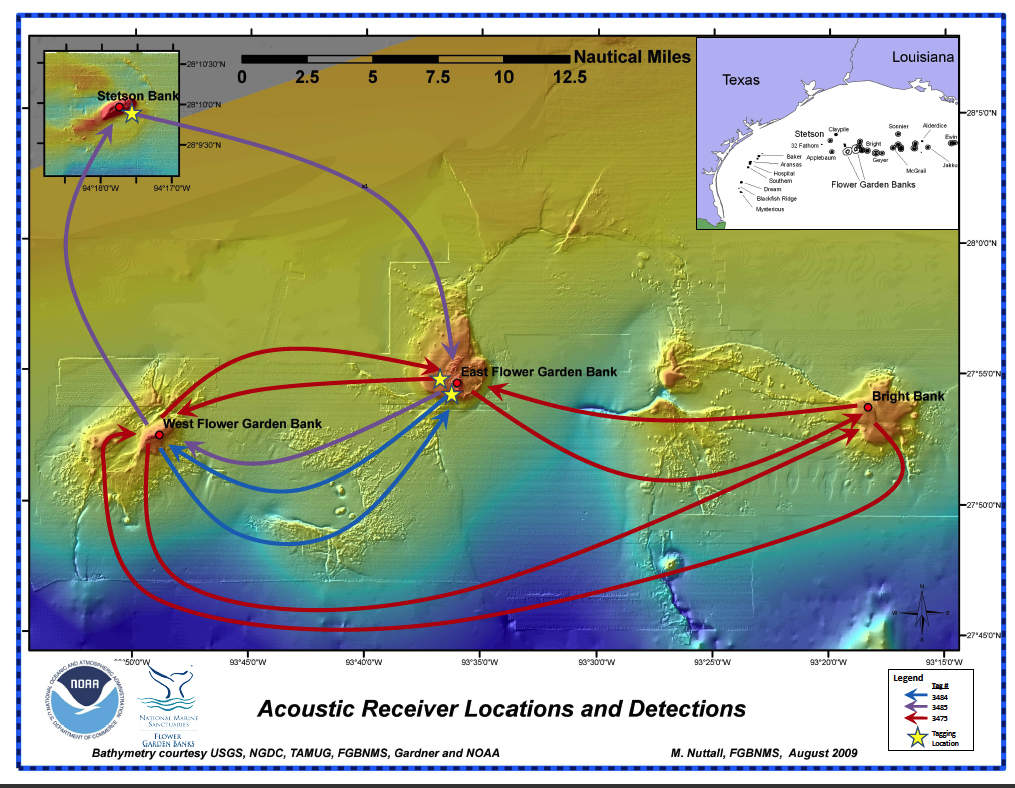MANTA RAY RESEARCH

There are still many unanswered questions about the manta rays of the Flower Garden Banks National Marine Sanctuary. How large is the visiting population? Is this a functional population consisting of both sexes, adults and juveniles, or is it segregated according to sex and/or size? Which species of manta ray visits the sanctuary? How much time do the rays actually spend in the sanctuary? Do changes in water temperature or lunar phases influence their travels or times they spend at the different banks? To help answer these and other questions, sanctuary staff are collaborating with the Wildlife Conservation Society in a shark and ray tagging effort.
Acoustic Tagging
In 2006, researchers Dr. Rachel Graham and Dan Castellanos, from the Wildlife Conservation Society, began a project to learn more about the movements of manta rays in and around the three banks that make up the Flower Garden Banks National Marine Sanctuary using underwater acoustics. As of October 2008, eight individual mantas have been successfully tagged with acoustic tags, and acoustic receivers placed at East Flower Garden Bank, West Flower Garden Bank and Stetson Bank.

A manta ray swims by an acoustic receiver at the Flower Garden Banks National Marine Sanctuary. The receiver is suspended above the reef to maximize its range.
Photo: Hickerson/FGBNMS
 |
|
Acoustic receiver
|
In order to widen the receiver network, additional instruments have been placed at Bright, Sonnier and Geyer Banks, outside sanctuary boundaries.
Every time a tagged manta swims within approximately 500 meters of any of the receivers, the unique pattern of sound pulses emitted by the tag is recorded along with the date and time. The receiver maintains a log of this data until researchers download the information at a later date.
top of page
What We've Learned So Far
Since the deployment of the receivers and tags in 2006 we have noted that two mantas tagged at East Bank traveled to West Bank (red and blue lines on map below). One of these returned to East Bank and has made two more trips to West Bank since (red lines on map below). Another manta tagged at Stetson Bank traveled to both East and West Banks then returned to Stetson Bank (purple lines on map below).

Red, blue, and purple lines on this map show the general movements of three tagged manta rays. (Click on the map for larger image.)
The sanctuary's acoustic array is part of a larger network of acoustic receivers called Marine Megafauna Acoustic Network (Marine Meganet). This is the largest acoustic array for tracking megafauna (whale sharks, mantas, grouper, and toothy sharks) that has been implemented in the Caribbean and Gulf of Mexico. Underwater receivers in this network are located at banks off the coast of Texas and Louisiana, Mexico, Belize, Honduras. Additionally, the Marine Meganet complements other arrays established in the Eastern Atlantic states, Canada, and soon Brazil.
top of page
To learn more about how we identify mantas that do not have acoustic tags, visit our Manta Catalog page.
Earlier work on manta rays at Flower Garden Banks National Marine Sanctuary was conducted by Jeffrey N Childs (2001), a graduate student from Texas A&M University.